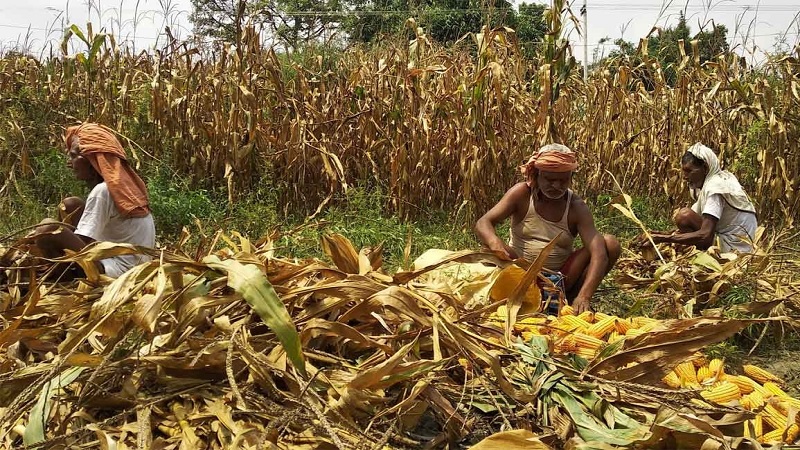 Image Courtesy:newsclick.in
Image Courtesy:newsclick.in
Although Bihar’s maize crop enjoyed a boom this year, farmers did not receive decent rates, said member of the All India Kisan Sangharsh Coordination Committee (AIKSCC) Ashish Ranjan on November 9, 2020. Local farmers claim that labour migration, among other issues caused by the lockdown, adversely affected current and future farming prospects.
“Ideally maize costs around Rs. 1,600 to Rs. 1,700 per quintal. The MSP [Minimum Support Price] is Rs. 1,850 per quintal as declared by the Union Cabinet Committee on Economic Affairs for marketing season 2020-21. However, farmers have only received Rs. 1,000 per quintal or Rs. 1,100 this year,” said Ranjan.
Bihar’s farmers spent the better part of kharif season demanding proper prices for their maize produce while political parties geared up for state elections. It may be mentioned that while many farmers from Madhepura, Araria and other districts observed a hunger strike in June, no political party included low maize prices or Minimum Support Prices (MSP) as a part of their manifestos.
According to Araria’s maize farmer Amar, traders are the only ones who have benefitted from this year’s crop yield.
“Last year, I sold 200 quintals of maize – less than this season’s sale. But I earned more in 2019 due to better price rates. I received Rs. 1,700 per quintal which went up to Rs. 2,000 per quintal by the end of the season,” said Amar.
This year, he sold 300 quintals for Rs. 1,000 per unit. Estimating an expenditure of Rs. 25,000 to Rs. 30,000 per acre on his 10-acre land, Amar has resolved to apply for another loan for the next season’s harvest.
Amar was one of the participants of the June hunger strike, demanding government assistance in the sale of maize crops. At the time, local authorities had promised to conduct a survey before answering their demands. However, Amar said that no one from the government ever came to his field to survey the state of his crops.
Bereft of any other means, farmers like him were forced to sell their produce to small traders who took the crop to big markets in Purnia and other districts and sold the produce at Rs. 1,200 per quintal.
Amar reasoned that the situation would have been better if farmers had proper go-downs or storage spaces to preserve their crops.
“If we had go-downs, we could wait for better prices to sell our produce. The monsoon rains also speed up our need to sell our crop before they are ruined,” he said.
While Araria’s private storehouses enjoy a capacity of around 50,000 tonnes, local farmers like Amar can only afford the Panchayat-level storehouses that have very little capacity. He argued that farmers would profit greatly if the state government created three or four go-downs at the Panchayat-level to help local farmers.
Ranjan reinforced this idea by saying that marginal farmers would also benefit from maize crops if the government provided facilities to deal with crop storage, irrigation, and regularisation of markets.
Most farmers in Bihar are market-dependent, which is ironic considering the state government abolished the APMC system in 2006. According to a 2019 study by the National Council for Applied Economic Research the abolition of APMC had resulted in increased volatility in crop prices which negatively affected farmers’ crop choices and decisions to adopt improved cultivation practices. The study showed that farmers have been left to the mercy of traders who unscrupulously fix lower prices for agricultural produce bought from farmers.
In the present, Amar fears that the labour migration caused by the lockdown would affect the harvest of the next season as well. The absence of labourers meant farmers would not be able to finish field-work on time. Moreover, he said the government had offered no benefits this year.
When asked about possible reliefs for farmers, Amar said that price subsidies for seeds, transport services and storage facilities could improve farmers’ situation immensely.
“Currently, maize seeds cost Rs. 300 per packet that yields 4kg of crop. If this seed-price is lowered, then I might be able to breakeven,” he said.
Maize became a popular crop over the last decade as its hybrid seeds gained popularity among farmers. By 2017, Bihar had become the third-largest producer of maize in India. Yet, farmers continue to suffer from little market access. Having done his bit for the state elections, Amar said, “I hope that a new government would look into our issues.”
Related:
Farmers answer second clarion call to protest anti-farmer laws
AIKSCC decries new Ordinance’s anti-farmer stand
New Central laws preventing us from checking prices of onion, pulses: Jharkhand Finance Minister
Kerala: New base prices for 16 agricultural produce won’t benefit rubber farmers
